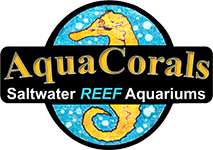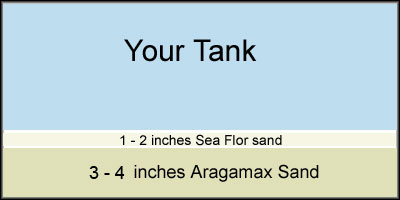
Deep Sand Bed
Filtration = DSB/LR/O (Deep Sand Bed / Live Rock / Overflow system):
Deep Sand Bed & Live Rock... This IS your "filter". (No mechanical/power filters or bio balls needed!) Any "filter" is a place where good bacteria lives that breaks down all the wastes. In mechanical/power driven filters the bacteria is provided "housing' on filter pads, "bio wheels", "bio balls" & other "medias". In a natural system (which simulates what Mother Nature does in our oceans) the vast majority of bacteria resides in & on the surface area of our live rock & sand.
I cannot stress enough how important this section is! To be successful with my "reef system recipe" you absolutely CANNOT skimp on the amount of live rock & depth of sand bed installed. These 2 areas do 99% of your system's filtration. Again, filtration is the breakdown of all wastes produced in the total system. Uneaten foods, fish excrement etc. It is critically important to have enough of both areas to harbor enough good bacteria to fully breakdown all wastes, producing a complete Nitrogen Cycle. There are 4 basic "good" bacteria, 3 of which need oxygen to live & the 4th likes low to no oxygen areas. The inner depths of your rock & lower levels of your sand will provide this anoxic area for this last, but VERY necessary bacteria...which breaks down NitrAtes.
1. Deep Sand Bed 4 – 6+ inches deep.

I recommend using a combination of 2 different grain sized substrates: First use 3 - 4 inches of “Carib Sea “Aragamax” a fine sand used on the bottom. I use this finer sand because it takes fewer inches to create a low to no oxygen region. Because it's very light it tends to blow around & irritate corals so we top the Aragamax with 1 - 2 inches "Carib Sea "Sea Flor”. The Sea Flor is a little heavier, larger grained sand which will hold down the lighter Aragamax but it still fine enough for all sand loving critters to utilize including Gobies, Cucumbers etc. Because the Aragamax fine sand compacts more tightly it will provide the bulk of low/no oxygen areas needed. Note: It is important to install the deep sand bed in the tank itself because this is where uneaten fish food & fish waste end up. Very little of that matter gets up to & through your overflow to a sump or refugium. Your tank sand bed is the workhorse of the entire system!
You can “seed” your sand with live sand if you wish to “jump start” your sand bed but this is not necessary as bacteria and life forms already present in the live rock will migrate to & seed your sand. Adding live sand will just help speed up the bacteria growing/cycling process.
How Much Sand To Use:
Tanks with a floor dimension of:
48" x 18":
Bottom Sand = 5 Bags of 30 Lb Aragamax sugar fine
Top Sand = 1 40Lb Bags of Sea Flor + 1 15Lb Sea Flor OR 3 20Lb bags of Aragalive
48" x 24":
Bottom Sand = 6 Bags of 30 Lb Aragamax sugar fine
Top Sand = 2 40Lb Bags of Sea Flor OR 4 20Lb bags of Aragalive
72" x 18":
Bottom Sand = 7 Bags of 30 Lb Aragamax sugar fine
Top Sand = 2 40Lb Bags of Sea Flor OR 5 20Lb bags of Aragalive
72" x 24":
Bottom Sand = 8 Bags of 30 Lb Aragamax sugar fine
Top Sand = 3 40Lb Bags of Sea Flor OR 6 20Lb bags of Aragalive
You don't have to use all dry or all live for your topper sand. You may mix them by swapping one product for another Lb for Lb. Sanding a tank is not an exact science so understand there is a little "wiggle room" in the above recommendations. :c)
You can add your dry sand products to your tank at any time, even if there is no water in the tank. You will want to rinse the dry sand products before placing in your tank. I like to fill a 5 gallon pail 1/2 way with sand then overfill the bucket with water. As the water is overflowing the pail I stir the sand. This allows only the dust particles to float away with the water. Rinse only until the water looks like watered down milk. Do not rinse any live sand product. Do not add your live sand until your tank is up running with the proper salinity & temperature to keep the bacteria alive.

